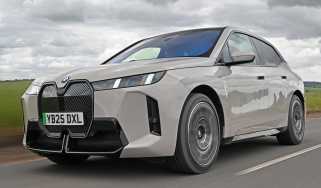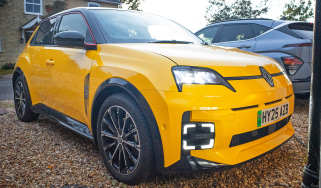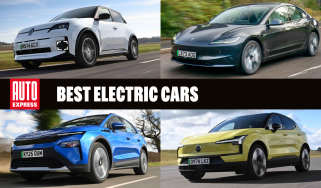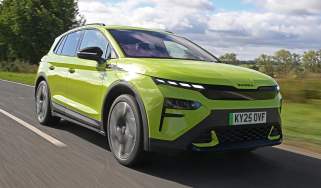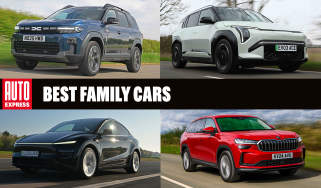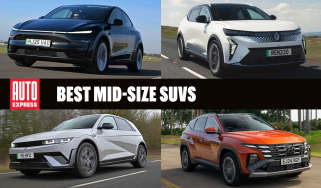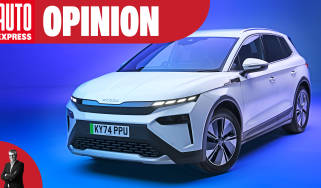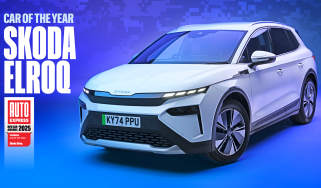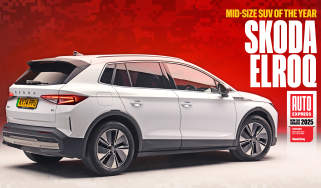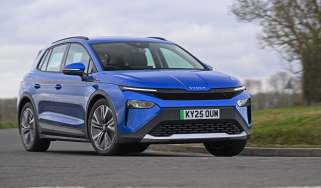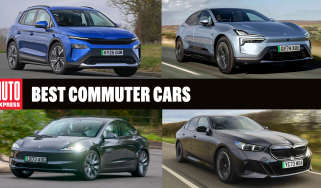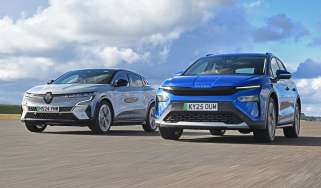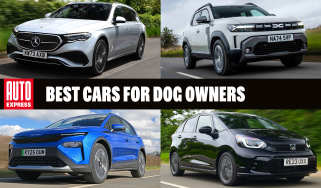Skoda Elroq review
The Skoda Elroq is even more appealing than the bigger Skoda Enyaq, and just as brilliant

Our opinion on the Skoda Elroq
It would be easy to say the Skoda Elroq is simply a shortened Skoda Enyaq, but there’s much more to the Czech firm’s latest electric car than that. It’s so good, we’ve not only awarded it our best mid-size SUV award, but our overall Car of the Year trophy, too.
But why is the Elroq so well regarded? Well, there’s a significant price saving for starters compared with its bigger sibling, and yet the Elroq doesn’t really sacrifice much in terms of practicality, refinement or performance. The Elroq offers decent driving range, impressive performance, and all of the practical touches that Skoda is famous for, giving justification for us to give this outstanding electric car the nod over its rivals.
About the Skoda Elroq
The Skoda Elroq (a portmanteau of Electric and Skoda Karoq), is the second electric Skoda model, and is pitched at those in the market for a family SUV that’s a little easier to park than the brand’s bigger Skoda Enyaq.
It uses the same platform as the Volkswagen ID.3, and is available in four different trim levels (SE, SE L, Edition and SportLine), and three variations of electric motor and battery capacity, offering between 232 miles of range for the entry-level Elroq 50, up to 355 miles of range for the Elroq 85. A hotter vRS version is also on the order books for those after four-wheel drive and a bit of extra punch off the line.
Skoda Elroq latest prices and deals
Pricing for the Elroq keeps rivals on their toes, and not just because it also qualifies for the UK Government’s £1,500 Electric Car Grant (EGC). This discount is applied automatically as part of the purchase, and makes our 2025 car of the year even more competitive compared with its closest rivals.
Four trim levels plus a high-performance model are available with prices (before the ECG) starting from:
- SE (from £32,000)
- SE L (from £33,500)
- Edition (from £34,500)
- SportLine (from £37,500)
- vRS (from £46,500)
We can help you configure your ideal Skoda Elroq and get great offers from local dealers. You can check out the latest Skoda Elroq leasing deals or search for used Skoda Elroq models with our Buy A Car service. You can also get a great price with Auto Express Sell My Car.
Electric motor, drive and performance

| Pros |
|
| Cons |
|
On the road, the Elroq is as composed, grippy and neatly balanced as you’d need a family car to be. In fact, it offers better ride comfort than much of its competition, with plenty of compliance and the ability to avoid jostling its occupants.
Electric motors, 0-60mph acceleration and top speed
There are three motor options in the Elroq range. The base 50 model has 168bhp and 310Nm and gets from 0-62mph in 8.7 seconds, while our preferred 60 version has an increased output of 201bhp (although the same 310Nm), cutting the 0-62mph dash to 7.7 seconds. The 85 turns the dial to 282bhp and 545Nm and chops the 0-62mph sprint to 6.4 seconds, while the range-topping vRS provides 335bhp and a 0-62mph dash of 5.4 seconds.
The Volkswagen Group has improved the throttle mapping of its current EV range compared to its earlier electric models, which previously felt quite lethargic when moving off. The Elroq is considerably more sprightly, but that hasn’t come at the expense of control, because there’s still plenty of pedal travel, so it’s easy to drive smoothly at low speeds.
| Model | Power | 0-60mph | Top speed |
| SE 50 | 168bhp | 8.7s | 99mph |
| SE L 60 | 201bhp | 7.7s | 99mph |
| SportLine 85 | 282bhp | 6.4s | 111mph |
| vRS | 335bhp | 5.4s | 111mph |
Town driving, visibility and parking
From the off, the Elroq avoids the irritatingly jiggly low-speed ride that many rivals suffer from. Even the optional 20-inch wheels of our test car didn’t spoil the suppleness of the ride unduly. The tight 9.3-metre turning circle of rear-wheel drive models is superb for a car of this size.
One area where we feel could be improved is braking. While we have no issues with its stopping power, the pedal feels soft through its initial travel, which isn’t confidence inspiring. We’d like the option to adjust brake regeneration via steering wheel-mounted paddles, similar to the Kia EV3 and Renault Megane. Only buyers of the Elroq SportLine and range-topping vRS get this useful feature.
B-road driving and handling
While the suspension feels forgiving around town, it is firm enough to give the Elroq decent body control at higher speeds on twistier roads. The light steering isn’t generous with feedback, but it is precise and allows drivers to guide the Elroq confidently. That’s backed up by a generous amount of grip and tight control of body movements.
The handling of the Elroq is very neutral, with harder acceleration in rear-wheel drive models gently pushing the back of the car around in a turn. It’s a stretch to call this Skoda fun, but it’s possible to flow the Elroq along a road better than a front-wheel drive Kia EV3.
The vRS, despite some suspension tuning, feels like a slightly sharper handling Elroq. Its wide-section Hankook tyres provide plenty of grip to carry some speed on the twisties, while the extra power is easily controlled by its four-wheel drive system. All this makes it effortless to drive at a pace rather than entertaining.
Motorway driving and long-distance comfort
Strong stability and impressive comfort are both evident in the Elroq’s motorway manners. A lack of vibration from the electric powertrain means the Elroq is a relaxing long-distance car.
Road noise is a little more hushed than the EV3, and the Skoda sits solidly on the road, requiring fewer steering corrections.
“I’ve driven both the Elroq 50 and Elroq 85 so far. There may be a near 120bhp difference between them, but at no point did we feel the base model was lacking power. It delivers brisk acceleration and there’s still enough oomph left for overtaking on the motorway without burying your foot in the carpet.” – Alex Ingram, chief reviewer
Range, charging & running costs
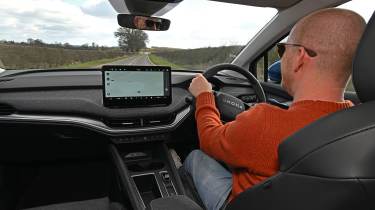
| Pros |
|
| Cons |
|
Electric range, battery life and charge time
There are four battery capacities available to buyers, and while the overall ranges aren’t quite class-leading, they are competitive. The base Elroq 50 has a 55kWh (52kWh usable) unit, which covers 232 miles between charges, based on WLTP figures, while the Elroq 60 with a 63kWh (59kWh usable) battery increases that figure to 265 miles.
The Elroq 85's 82kWh (77kWh usable) battery offers 355 miles, while the vRS can only manage 339 miles despite using a bigger 84kWh (79kWh usable) battery because its four-wheel drive system negatively impacts efficiency.
We tested the Elroq 60 in our Renault Megane twin test, and averaged 3.7 miles/kWh or 218 miles of range. That’s a little down from Skoda’s official claim of 3.9mi/kWh, but our figure included plenty of motorway driving in cool conditions, neither of which is flattering for an EV’s range. Warmer weather and more driving at lower speeds will see that figure climb, along with a heat pump (a less energy-intensive way of warming the interior in cold weather). It's a shame that the latter is a pricey £1,000 extra.
With a maximum charging speed of 145kW, the Elroq 50 manages a 10-80 per cent top-up in 25 minutes from an ultra-rapid charger. Alternatively, fully replenishing the battery via a 7.4kW home wallbox takes around seven hours. The mid-range Elroq 60 can hit a peak of 165kW, so charging from 10-80 per cent takes 24 minutes. A 7.4kW charger takes around nine hours to fully recharge the battery.
The Elroq 85 model peaks at 175kW, but due to its larger battery, charging from 10-80 per cent will take 28 minutes. That extra battery size means a 7.4kW charger takes around 12 hours to fully recharge. The slightly larger battery in the vRS takes a similar amount of time to recharge from a 7.4kW charger, but its higher peak DC charging speed of 185kW means a 10-80 per cent top up can be done a little quicker, in 26 minutes.
Skoda allows preconditioning the battery en route to a charging station, ensuring that the pack is ready for rapid charging. By doing this, we found the Elroq regularly hit its claimed charging speeds, but as with any other electric vehicle, the maximum rate tails off as the level of battery charge increases.
| Model | Battery size | Range | Insurance group |
| SE 50 | 55kWh (52kWh usable) | 232 miles | 22 |
| SE L 60 | 63kWh (59kWh usable) | 265 miles | 27 |
| Sportline 85 | 82kWh (77kWh usable) | 355 miles | 34 |
| vRS | 84kWh (79kWh usable) | 339 miles | 37 |
Insurance groups
There’s some disparity in insurance groups as you climb up the Elroq ladder, because the entry-level SE 50 is in group 22, while the SE L 60 jumps to group 27. The SportLine 85 trim sits in group 34, while the top-spec vRS is in group 37.
The Elroq starts in a lower insurance group than the Kia EV3 and should, therefore, be more affordable to insure.
Tax
As of April 2025, the Elroq is in the lowest three per cent Benefit-in-Kind (BiK) tax band. That means that company car drivers in the standard rate income tax bracket face deductions of only £200 a year for the Elroq SE L 60.
Electric cars are no longer exempt from annual vehicle excise duty (VED). The majority of the Elroq range costs less than £40,000, avoiding the luxury car tax threshold. Be warned, some versions of the 85 and the vRS are above this limit and incur a hefty surcharge payable from the second time the vehicle is taxed up until it is six years old. On the plus side, the Elroq should be able to escape the London congestion charge, at least until December 2025.
Depreciation
The Elroq is predicted to hold on to between 48 and 52 per cent of its original value after three years or 36,000 miles. That’s a little better than the Kia EV3 (45-49 per cent) and Renault Megane (45-49 per cent) over the same period.
To get an accurate valuation for a specific model, check out our free car valuation tool...
Design, interior & technology
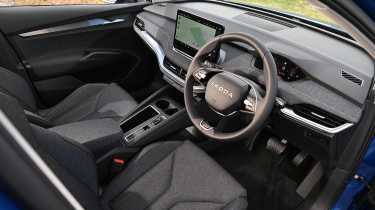
| Pros |
|
| Cons |
|
The Elroq is the first car to be designed according to Skoda‘s ‘Modern Solid’ philosophy, which has since been adopted by the Enyaq. Many details are similar to its big brother, to the point that most people will be hard-pressed to spot any differences beyond the Elroq’s shorter, stockier proportions.
Step inside and the cabin design is largely the same as the Enyaq’s, right down to the stubby gear selector on the floating centre console and the bank of large shortcut buttons across the dashboard.
You won’t feel shortchanged with the entry-level SE trim, but we’d recommend spending a little more to get our preferred SE L trim because it includes useful extras such as:
- Heated front seats and steering wheel
- Sat-nav
- Front parking sensors
- Comes as standard with a larger 63kWh battery
Further up the Elroq range is the Edition trim, which has larger 19-inch wheels and keyless entry and start, while SportLine looks sportier by aping the vRS - just without the performance and price. The vRS somewhat justifies its price increase by being the quickest Elroq and the only way of getting this model with four-wheel drive. Plus, it has a head-up display, upgraded Canton sound system, and adaptive suspension.
Interior and dashboard design
The Elroq features a clean, uncluttered design that’s easy to understand, and SportLine and vRS trim levels add sportier details, such as a three-spoke steering wheel and aluminium pedals.
It’s a shame that the Elroq doesn’t get the rotary multi-function climate control dials used by the latest Skoda Superb and Skoda Kodiaq, which went down well with our testers during the 2025 car infotainment mega test for reducing distractions and making simple tasks like changing the climate control temperature easier to do. The on-screen temperature controls in the Elroq are at least permanently on display along the bottom of the screen, making them easier to find while driving, but it would be better if there were a physical dial you could reach out and turn using muscle memory rather than having to look away from the road at a screen.
Materials and build quality
For the past four or five years, Skoda has delivered levels of perceived quality that punch above other Volkswagen Group alternatives. The interior of the Elroq feels similarly well-built, and we like the different material choices you get with each interior theme.
Indeed, it’s only really the Peugeot E-3008 that offers plusher materials in the family-SUV segment, but the French model costs significantly more than the Elroq.
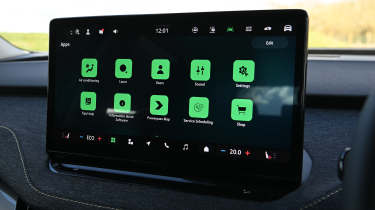
Infotainment, sat-nav and stereo
The driver gets a small digital instrument panel, and while it isn’t as fancy as bigger displays used by rivals, it presents the most important information clearly. A head-up display is available, which projects the speed and other important information onto the windscreen within the driver’s line of sight. It’s standard on vRS models, and available as part of the pricey Advance pack on SE L trim and above.
The Elroq’s 13-inch infotainment screen is standard, and aside from its awkward dash-top placement, it’s a far cry from the glitchy and confusing touchscreen system of earlier MEB-based cars. Its main menu is separated into useful widgets, while customisable shortcuts make the most commonly used settings easier to find. We’d like more scope for choosing which features can be added to the shortcut menu, but the system overall looks great and loads quickly.
A fairly ordinary sounding eight-speaker sound system comes as standard, while a 12-speaker, 675-watt Canton sound system is standard on vRS or as part of the Advance or Maxx equipment packages on SE L and Edition trims. Wireless phone charging is provided on Edition trim and above, and can be added to SE L trim. Base SE misses out on this feature, though.
“The Elroq comes with a choice of interior finishes. The SE, SE L, and Edition variants’ standard Loft design uses woven fabric on the dashboard and seats. SE L and Edition trims can be upgraded to Suite with part leather across the dash and seat faces. But Lodge has the more eye-catching two-tone light grey/black upholstery highlighted by orange seat belts and stitching.” – Alex Ingram, chief reviewer
Boot space, comfort & practicality

| Pros |
|
| Cons |
|
An SUV-sized car for hatchback money, the Elroq is impressively spacious compared with similarly priced alternatives.
The Elroq feels very roomy up front, while passengers in the back are spoiled for space.
Dimensions and size
The Elroq is shorter than the Enyaq by around 200mm, but it’s fractionally wider, so cabin space is similar between the two. The Elroq is larger than similarly priced rivals such as the Renault Megane and Kia EV3.
| Dimensions | |
| Length | 4,488mm |
| Width | 1,884mm (2,148mm inc mirrors) |
| Height | 1,625mm |
| Number of seats | Five |
| Boot space | 470-1,580 litres |
Driving position, seats & space in the front
The driver is treated to a seat and steering wheel with a wide range of adjustment as standard, but you can add an electric driver’s seat with memory function to SE L and SportLine trims as part of the Advance pack, or the Maxx pack if you’re buying the vRS. The Elroq has deep cup-holders, a large storage bin beneath the central armrest, and wide door pockets.
The deep windscreen provides a clear view of the road, and the ridges in the bonnet highlight the extremities of the car. The back window isn’t huge, but there’s better rearward visibility than in a Kia EV3 or Renault Megane.
Seats & space in the back
Against the tape measure, we found that the Elroq is pretty much a match for head and knee room to the larger Enyaq. Like many electric cars, the rear floor in the Elroq is high to accommodate the battery underneath. This can leave long-legged passengers without much under-thigh support, but Skoda’s simple yet effective solution is to extend the seat bases.
Isofix child seat mounts are easy to reach, while a wide door opening makes installing a child seat simple. It’s a little stingy that only Edition models and up get extra USB charging ports for those in the back, though.
Boot space
The only area where the Elroq sacrifices anything to the Enyaq is in the boot. Even so, 470 litres will be plenty for most families, and there’s underfloor storage for the charging cables, plus a load of smart little shelves and nooks for storing smaller items. Further to that, the optional transport package introduces a range of nets to hold things securely in place, along with a reversible boot floor.
The parcel shelf can be repositioned to divide the boot depending upon what you’re carrying and take a load of up to 3kg. Removing it and dropping the 60/40 split rear seats reveals a 1,580-litre black hole, compared with the 1,250 litres of space in a Kia EV3.
The trademark Skoda ice scraper/tyre tread-depth gauge is now stowed in the boot trim rather than its usual home in the fuel filler flap of internal combustion-powered Skodas.
“Back-seat occupants benefit from almost as much storage as those in the front. Small pockets in the front seat backs are ideal for holding a smartphone, while the removable plastic storage box of the optional Storage Pack fits neatly into the floor behind the centre console. Without it, the floor area is almost totally flat.” – Alex Ingram, chief reviewer
Safety & reliability
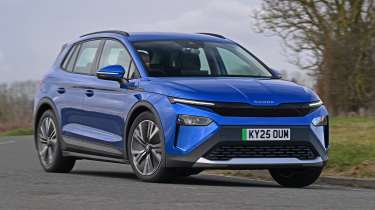
| Pros |
|
| Cons |
|
The Skoda brand has jumped from 23rd place (out of 32 in 2024) to 12th position out of 31 brands included in the 2025 Driver Power customer satisfaction survey manufacturer rankings. That's ahead of stablemates SEAT (24th), VW (27th), and Cupra (28th). However, it’s a long way behind the Renault brand in 6th place, which shows the French brand is really getting on top of providing the ownership experience customers expect.
Euro NCAP hasn’t tested the Elroq yet, but we expect it to gain a five-star score like the structurally similar Enyaq. All models come loaded with safety assistance features as standard, including lane keep assistance to help keep you within your lane, along with blind spot monitoring to warn you of vehicles alongside you when you go to change lanes.
| Key standard safety features |
|
Buying and owning
Best buy: Skoda Elroq SE L 60
The SE L 60 with a 59kWh battery is a great option, because it comes with all the features we expect in a family car and a decent driving range for the money. The SE L 80, with a larger 77kWh battery, is offered for long-distance drivers. However, its hefty price jump of £3,500 over an SE L 60 doesn’t seem like good value, considering an 81.4kWh Kia EV3 goes 20 miles further on a charge and is £1,000 less than an Elroq SE L 80.
All Skodas have a three-year warranty, while the Elroq gets eight years of cover for the battery pack. A single year of roadside assistance is no better than rivals.
Service intervals for the Elroq come every two years, just like you get on the Volkswagen ID.3. Skoda offers buyers a package that allows the cost of this maintenance to be spread across monthly payments.
Skoda Elroq alternatives
The Skoda Elroq is hard to beat, but if you want more range, the excellent Kia EV3 is worth a look. However, we think the Skoda deserves its lead thanks to greater comfort, refinement and handling, as well as better in-car tech and much more space.
Renault’s EV line-up is in fantastic form, but even that has a tough challenge to face here, because the Elroq is offering buyers Renault Scenic size for Renault Megane E-Tech money.
Potential buyers may also be cross-shopping the Elroq with the Hyundai Kona Electric and Volvo EX30, or perhaps the MINI Countryman Electric, with its funky interior and sense of fun.
Deals on the Skoda Elroq and alternatives
Skoda Elroq pictures
Frequently Asked Questions
The Skoda Elroq is relaxing and comfortable to drive, while the interior feels sophisticated. We also like all the ingenious touches that Skoda is known for.


